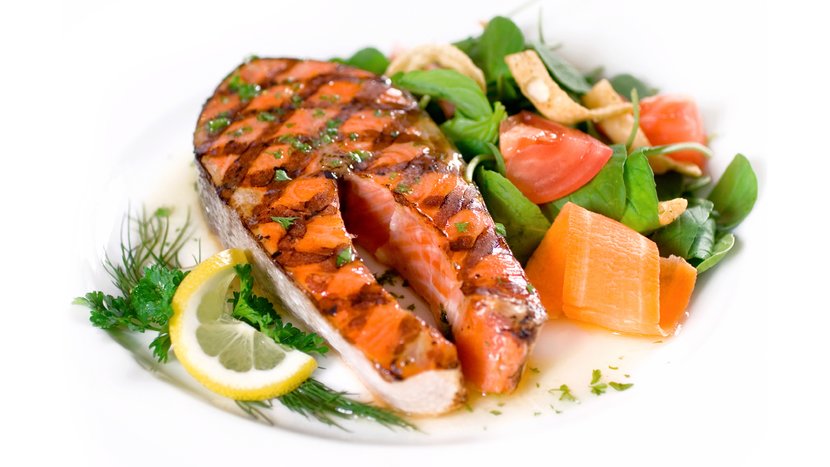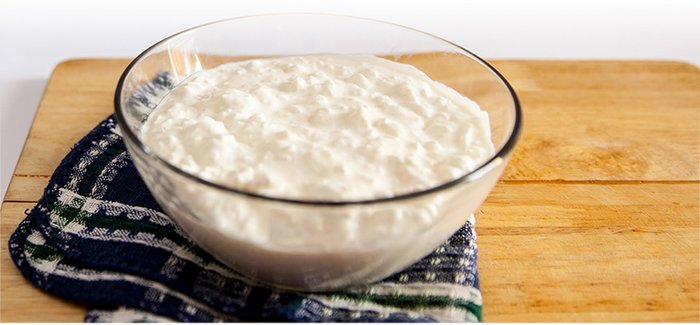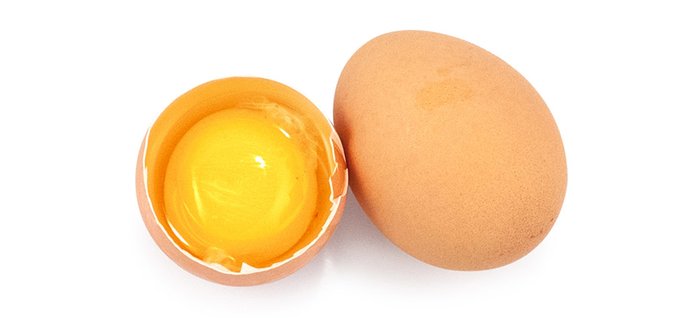
Protein builds your body. It creates muscle. It controls hunger. Win-win. Eating enough is key, but so is variety, since each protein has its own combination of amino acids. Go beyond the chicken zone with these great protein picks.
Greek Yogurt
Protein Power: 23 g per 8 oz. serving
Greek has become such a popular yogurt choice because it has twice as much protein as other types of yogurt. It's also rich in calcium and probiotic bacteria, which is great for gut health. Look for plain Greek yogurt to keep sugar in check.
Cottage Cheese
Protein Power: 14 g per 1/2 cup serving
Make cottage cheese your go-to protein for a late-night snack. It's high in casein, a dairy protein that digests more slowly than [whey](https://www.bodybuilding.com/content/your-expert-guide-to-whey-protein.html “whey”]). This accomplishes two goals: It feeds your muscles all night so they don't catabolize, and it keeps you from waking up starving at 3 a.m.

Swiss Cheese
Protein Power: 8 g per 1 oz. serving
Ounce for ounce, Swiss cheese provides more protein than other commonly available varieties in the supermarket, making it a muscle-friendly option for your sandwiches and burgers. If you're concerned about the calorie density of full-fat Swiss, low-fat versions have a protein-to-fat ratio of around 8-to-1 while still providing good flavor.
Eggs
Protein Power: 6 g per 1 large egg
These white orbs are a near-perfect muscle food: cheap, versatile, and packed with branched-chain amino acids. Look for eggs fortified with extra omega-3 fatty acids to make your morning scramble work even harder for you.

2-Percent Milk
Protein Power: 8 g per 1 cup serving
You could chug watery, flavorless skim milk, or you could enjoy the richer taste of 2 percent while getting a little extra fat to help you absorb the milk's vitamin D and get you closer to your macro targets. Organic milk has the highest nutrient content, including protein and omega-3s.[1]
Whey or Casein Protein Powder
Protein Power: 24 g per scoop, on average
Whey protein is one of the cleanest, fastest-digesting proteins on the market. It's also one of the most convenient—just mix it with water in a shaker bottle. Reach for whey whenever you need quick, no-prep protein: after a workout, for an on-the-go breakfast, or alongside a low-protein meal.
If you need something that'll help you hide from hunger a little longer, go for slow-digesting casein powder instead. It won't hit your muscles as fast, but it can keep you full for hours.
Steak (Top or Bottom Round)
Protein Power: 23 g per 3 oz. serving
These leaner cuts of steak provide a fantastic 1 g of protein for every 7 calories; rib eye, on the other hand, delivers roughly 1 g of protein for every 11 calories. Plus, round steak is considered one of the more economical cuts. Leaner cuts of steak like round and loin will become drier than the Sahara with overcooking, so prepare them quickly over high heat to just medium-rare.
Ground Beef (90% Lean)
Protein Power: 18 g per 3 oz. serving
Using 90 percent ground beef provides just the right amount of fat so your burgers and meatloaf won't taste like cardboard. Beyond a payload of protein, this red meat is also a good source of the almighty creatine.If you've got some extra cash in your wallet, opt for grass-fed beef, which is more nutrient-dense than its factory-farm counterparts.[2]
Pork Chops (Boneless)
Protein Power: 26 g per 3 oz. serving
The bounty of muscle-sculpting protein in easy-to-prepare pork chops gives you more than enough of an excuse to pig out on them.Pro tip: Soaking your chops in brine can yield more tender meat. Submerge the meat in a brine made with 1/4 cup salt for every 4 cups of water, and chill for 30 minutes to 2 hours.
Chicken Breast (Boneless and Skinless)
Protein Power: 24 g per 3 oz. serving
This bodybuilding staple delivers more protein than other poultry cuts, which is why it should remain a constant presence in your shopping cart. To keep more greenbacks in your wallet, get chummy with the meat guy at your supermarket, who can give you a heads-up when the poultry is likely to be marked down for quick sale.
Turkey Breast
Protein Power: 24 g per 3 oz. serving
As with chicken, this big bird can flood your muscles with a wallop of protein. Like pork chops and chicken breast, turkey breast can benefit from a pre-cook brining. If you're concerned about antibiotic use in large-scale poultry farming, you can look for turkey breast labelled "antibiotic-free."
Yellowfin Tuna
Protein Power: 25 g per 3 oz. serving
This meaty swimmer delivers a boatload of easily digested, premium-quality protein. You'll also benefit from the healthy amount of B vitamins and the potent antioxidant selenium in its flesh.When possible, look for troll- or pole-caught [tuna](http://: https://www.bodybuilding.com/fun/8-ways-to-prepare-tuna.html), which are the most sustainable options.
Halibut
Protein Power: 23 g per 3 oz. serving
Among white fish species, halibut reigns supreme when it comes to the protein you need to build muscle like a champ. Each 3-oz. serving also has a mere 2 g of fat, making halibut an even better catch of the day.Pacific halibut is generally considered a more sustainable choice than Atlantic.
Octopus
Protein Power: 25 g per 3 oz. serving
An increasing number of fishmongers are now offering up this seafood choice. So if your goal is to pack on granite-dense muscle you'd be a sucker not to reel it in for its protein windfall.Frozen octopus actually has an advantage over fresh because the freezing process helps tenderize the meat.
Sockeye Salmon
Protein Power: 23 g per 3 oz. serving
Not only does wild salmon like sockeye taste better than its farmed cousin, it also supplies more protein. In addition, you'll reap the benefits of its plethora of fat-fighting long-chain omega-3 fatty acids. Look for salmon with the skin still intact, as it provides added flavor during cooking.
Tilapia
Protein Power: 21 g per 3 oz. serving
Commonly available at most fish markets, tilapia provides an approachable, mild-tasting fish choice that will give you laudable amounts of protein to keep your muscles well-fed.Look for American-farmed tilapia, which is a safer choice than tilapia imported from Asia.
Anchovies
Protein Power: 24 g per 3 oz. serving
Ounce for ounce, these tiny swimmers are the surprising winners when it comes to canned protein. Because of their size, they also don't accumulate toxins the same way that bigger species do. To reduce their saltiness, soak anchovies in water for 30 minutes; then drain and pat dry.
Corned Beef
Protein Power: 24 g per 3 oz. serving
The lofty protein levels in this salt-cured beef is sure to, well, beef up your muscles.Try sautéing corned beef with chopped vegetables and serve over rice, or pile it on rye with plenty of mustard.
Light Tuna
Protein Power: 22 g per 3 oz. serving
Frugal shoppers rejoice: Less-pricey canned light tuna actually provides a little more protein than more expensive canned white tuna. To save yourself some calories sourced from lackluster vegetable oils, opt for water-packed tuna.
Canned Chicken
Protein Power: 21 g per 3 oz. serving
Pop the lid on ground white chicken meat to instantly add a shot of high-quality protein to your sandwiches and salads. Treat it the same way you would canned tuna. Compare brands, looking for those that deliver lower amounts of sodium.
Sardines
Protein Power: 21 g per 3 oz. serving
Humble canned sardines are making a comeback! This oily little fish is full of protein, omega-3 fats, and vitamin D, and is relatively low in mercury since it's small and low on the food chain. Try stirring them into mashed potatoes or cauliflower to cut their strong taste.
Navy Beans
Protein Power: 20 g per 1 cup serving
Beans are a fantastically cheap source of protein, and of the most commonly available canned legumes, navy beans lead the way. Each cup also supplies an impressive 13 g of dietary fiber. Mash them with garlic and lemon as a hummus alternative.
Dried Lentils
Protein Power: 13 g per 1/4 cup serving
Inexpensive dry lentils are a sure-fire way to ramp up your intake of protein, fiber, and a range of vital minerals. Unlike other dried beans, lentils don't require an annoying presoak. Simply simmer until tender, about 20 minutes. For a nutritious lunch, toss cooked lentils with chopped chicken breast, diced vegetables, and a lemon vinaigrette.
Roast Beef
Protein Power: 18 g per 3 oz. serving
Roast beef is leaner than you'd think, and higher in protein than other deli counter picks. As with steak, pasture-raised roast beef is more nutritious. Make a roast beef sandwich with spinach and red onions, or just snack on it as-is.
Canadian Bacon
Protein Power: 15 g per 3 oz. serving
Hailing from the leaner back of the pig, Canadian-style bacon has about six times less fat than traditional bacon, giving it a much better protein-to-fat ratio. You may also encounter Canadian bacon by its other name: peameal bacon. And yes, we just gave you permission to eat bacon.
Chorizo
Protein Power: 21 g per 3 oz. serving
This Spanish-style seasoned pork sausage can turn pasta dishes, scrambled eggs, soups, and salads into a protein- and flavor-packed meal. Spanish chorizo is cured, so it doesn't need to be cooked before eating, but Mexican chorizo does.
Pepperoni
Protein Power: 18 g per 3 oz. serving
The stellar amount of protein in pepperoni makes it a surprisingly healthy topping for pizza or salad. Sodium levels can vary widely, so compare brands and look for options with the lowest amount.
Roasted Turkey Breast
Protein Power: 18 g per 3 oz. serving
Being nearly fat-free, slices of deli turkey are almost pure muscle-making protein, so pile it high. Steer clear of flavored turkey and other deli meats to avoid bringing home stuff you don't need, like salt, sugar, and lab-made flavorings.
Beef Jerky
Protein Power: 13 g per 1 oz. serving
Cleaning up your diet might mean saying goodbye to potato chips and microwave popcorn, but you can still enjoy jerky for a salty treat that doesn't derail your goals. Keep some in your desk at work or sneak it into the movies. Look for healthier brands that are free of MSG and nitrites.
Peanut Butter
Protein Power: 8 g per 2 tbsp serving
Though not as trendy as other nut butters like almond, ye olde peanut butter still leads the way in the protein department. Watch labels for sugar. Natural peanut butters made from just peanuts are best—some stores even let you grind your own.
Mixed Nuts
Protein Power: 6 g per 2 oz. serving
Nuts like peanuts, cashews, and almonds make for a crunchy way to add more protein and healthy unsaturated fats to your diet. Keep a can in your glove compartment for hunger emergencies. If you're watching your sodium intake, look for packages labelled "unsalted".
Bean Chips
Protein Power: 4 g per 1 oz. serving
If you're jonesin' for crunchy chips, you'll be hard-pressed to find a better option than the ones made with protein-rich black beans. For bonus points, use them as a delivery vessel for a homemade Greek yogurt dip.
Smoothies
Protein Power: 16 g per 1 cup serving
Up your protein shake game by blending whey or casein powder into a smoothie with fruit and other goodies. You can also buy premade smoothie drinks, but make sure they have a substantial dose of protein (around 20 g for a 2-cup bottle) and not just fruit, which can send you into sugar overload.
Tofu
Protein Power: 12 g per 3 oz. serving
If you're looking to embrace Meatless Mondays, slabs of tofu can make sure your protein intake doesn't suffer. Slices of firm tofu work well in stir-fry, or try slapping them on the grill to infuse them with some smoky flavor. A good marinade goes a long way.
Edamame
Protein Power: 8 g per 1/2 cup serving
Another great vegetarian option, these green soybeans will give your diet a boost of plant protein, fiber, vitamins, and minerals.To upgrade your snack time, prepare shelled frozen edamame according to package directions, then season with fresh lemon juice, smoked paprika, and a whisper of salt.
Green Peas
Protein Power: 7 g per 1 cup serving
While protein is not abundant in most vegetables, green peas contain enough that you'll want to keep a bag stashed in your freezer at all times. They're also a good source of fiber to help keep cravings for junk food at bay.
Frozen Greek Yogurt
Protein Power: 6 g per 1/2 cup serving
Frosty and creamy like ice cream, but with the benefit of containing about twice as much high-quality protein. Compare brands and look for those with the lowest sugar levels. Some brands actually list fruit before sugar in the ingredient list, which is a plus.
Wheat Germ
Protein Power: 6 g per 1 oz. serving
The wheat grain is made up of three components—endosperm, bran, and germ. The germ is the most nutrient-dense part and includes notable amounts of plant-based protein. You can use it to add a protein boost to your oatmeal, pancakes, and even shakes.
Soba Noodles
Protein Power: 12 g per 3 oz. serving
Consider using these buckwheat Japanese-style noodles for your pasta nights since they contain more protein than most wheat-based noodles. Even better, they cook in about half the time as whole-wheat pasta.To remove the excess starch that can make the noodles gummy, rinse cooked soba after draining.
Quinoa
Protein Power: 8 g per 1 cup serving
Among whole grains, South American quinoa (technically a seed) is a rarity in that it contains a full arsenal of essential amino acids, meaning that it's a complete protein with muscle-making potential.Toasting quinoa in a dry skillet or saucepan before simmering it in water can enhance its natural nutty flavor.
- Palupi, E., Jayanegara, A., Ploeger, A., & Kahl, J. (2012). Comparison of nutritional quality between conventional and organic dairy products: a meta‐analysis. Journal of the Science of Food and Agriculture, 92(14), 2774-2781.
- Daley, C. A., Abbott, A., Doyle, P. S., Nader, G. A., & Larson, S. (2010). A review of fatty acid profiles and antioxidant content in grass-fed and grain-fed beef. Nutrition Journal, 9(1), 10.
Original article and pictures take www.bodybuilding.com site
Комментариев нет:
Отправить комментарий